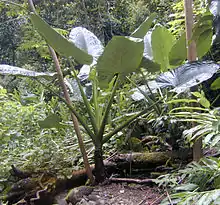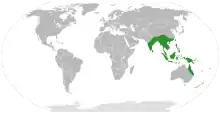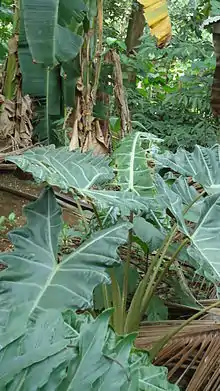Alocasia
Alocasia is a genus of broad-leaved rhizomatous or tuberous perennial flowering plants from the family Araceae. There are 79 species [2] native to tropical and subtropical Asia to Eastern Australia, and widely cultivated elsewhere.
| Alocasia | |
|---|---|
 | |
| Alocasia macrorrhizos | |
| Scientific classification | |
| Kingdom: | Plantae |
| Clade: | Tracheophytes |
| Clade: | Angiosperms |
| Clade: | Monocots |
| Order: | Alismatales |
| Family: | Araceae |
| Subfamily: | Aroideae |
| Tribe: | Colocasieae |
| Genus: | Alocasia (Schott) G.Don |
| Type species | |
| Alocasia cucullata | |
 | |
| Range of the genus Alocasia. | |
| Synonyms[1] | |
| |
Description
The large cordate or sagittate leaves grow to a length of 20 to 90 cm on long petioles. Their araceous flowers grow at the end of a short stalk, but are not conspicuous; often hidden behind the leaf petioles.
The corms of some species can be processed to make them edible, but the raw plants contain raphid or raphide crystals of calcium oxalate along with other irritants (possibly including proteases)[3] that can numb and swell the tongue and pharynx; they cause difficulty in breathing, and sharp pain in the throat. The lower parts of the plant contain the highest concentrations of the poison. Prolonged boiling before serving or processing may reduce the risks, and acidic fruit such as tamarind may dissolve the raphides. However the species vary in toxicity, and it is dangerous to experiment with the edibility of any Alocasia.
Cultivation
Alocasia are tropical plants that are increasingly becoming popular as houseplants.[4] The hybrid A. × amazonica has gained the Royal Horticultural Society's Award of Garden Merit.[5] They are typically grown as pot plants, but a better way is to grow the plants permanently in the controlled conditions of a greenhouse. They do not do well in the dark and need good lighting if inside the house. They should be cared for as any other tropical plant with weekly cleaning of the leaves and frequent fine water misting without leaving the plants wet.
They rarely survive cold winters or the dryness of artificial heating, but an attempt to slowly acclimatize plants from the summer garden to the house can help.[6] Once inside, the watering period must be reduced and the plants should be protected from spider mites or red spider attack.
Species
The following are the accepted species classified under Alocasia along with their common names (where available) and distribution ranges:


- Alocasia acuminata Schott: (Indonesia)
- Alocasia aequiloba N.E.Br.: (New Guinea)
- Alocasia alba Schott: (Sri Lanka)
- Alocasia arifolia Hallier f.: (Malaysia)
- Alocasia atropurpurea Engl.: (Philippines)
- Alocasia augustiana L.Linden & Rodigas: (New Guinea)
- Alocasia baginda Kurniawan & P.C.Boyce: (Kalimantan)
- Alocasia balgooyi A.Hay: (Sulawesi)
- Alocasia beccarii Engl.: (Malaysia)
- Alocasia boa A.Hay: (New Guinea)
- Alocasia boyceana A.Hay: (Philippines)
- Alocasia brancifolia (Schott) A.Hay: (New Guinea)
- Alocasia brisbanensis (F.M.Bailey) Domin: Cunjevoi, spoon lily (Australia)
- Alocasia cadieri Chantrier: (SE Asia)
- Alocasia celebica Engl. ex Koord: (Sulawesi)
- Alocasia clypeolata A.Hay: Green shield (Philippines)
- Alocasia cucullata (Lour.) G.Don in R.Sweet: Chinese taro (Indonesia)
- Alocasia culionensis Engl.: (Philippines)
- Alocasia cuprea K.Koch: (Borneo)
- Alocasia decipiens Schott: (Indonesia)
- Alocasia decumbens Buchet: (Vietnam)
- Alocasia devansayana (L.Linden & Rodigas) Engl.: (New Guinea)
- Alocasia fallax Schott: (East Himalaya to Bangladesh)
- Alocasia flabellifera A.Hay: (New Guinea)
- Alocasia flemingiana Yuzammi & A.Hay: (Java)
- Alocasia fornicata (Roxb.) Schott: (India, Indonesia)
- Alocasia gageana Engl. & K.Krause in H.G.A.Engler: (Burma)
- Alocasia grata Prain ex Engl. & Krause in H.G.A.Engler: (Indonesia)
- Alocasia hainaica N.E.Br.: (Hainan to N. Vietnam)
- Alocasia heterophylla (C.Presl) Merr.: (Philippines)
- Alocasia hollrungii Engl.: (New Guinea)
- Alocasia hypnosa J.T.Yin, Y.H.Wang & Z.F.Xu: (Southwest China to Indochina)
- Alocasia hypoleuca P.C.Boyce: (Thailand)
- Alocasia infernalis P.C.Boyce: (Borneo)
- Alocasia inornata Hallier f.: (Sumatra)
- Alocasia jiewhoei V.D.Nguyen: (Cambodia)
- Alocasia kerinciensis A.Hay: (Sumatra)
- Alocasia lancifolia Engl.: (New Guinea)
- Alocasia lauterbachiana (Engl.) A.Hay: (New Guinea)
- Alocasia lecomtei Engl.: (Vietnam)
- Alocasia longiloba Miq.: (Malaysia)
- Alocasia macrorrhizos (L.) G.Don in R.Sweet: Giant taro, elephant ear, ape flower (SE Asia, Australia, Pacific)
- Alocasia megawatiae Yuzammi & A.Hay: (Sulawesi)
- Alocasia maquilingensis Merr.: (Philippines)
- Alocasia melo A.Hay: (Borneo)
- Alocasia micholitziana Sander: Green velvet (Philippines)
- Alocasia minuscula A.Hay: (Borneo)
- Alocasia monticola A.Hay: (New Guinea)
- Alocasia navicularis (K.Koch & C.D.Bouché) K.Koch & C.D.Bouché: (Himalaya)
- Alocasia nebula A.Hay: (Borneo)
- Alocasia nicolsonii A.Hay: (New Guinea)
- Alocasia nycteris Medecilo, G.C.Yao & Madulid: (Philippines)
- Alocasia odora (Lindl.) K.Koch: Night-scented lily (SE Asia, China)
- Alocasia pangeran A.Hay: (Borneo)
- Alocasia peltata M.Hotta: (Borneo)
- Alocasia perakensis Hemsl.: (Malaysia)
- Alocasia portei Schott: (New Guinea)
- Alocasia princeps W.Bull: (Malaysia)
- Alocasia principiculus A.Hay: (Borneo)
- Alocasia puber (Hassk.) Schott: (Java)
- Alocasia puteri A.Hay: (Borneo)
- Alocasia pyrospatha A.Hay: (New Guinea)
- Alocasia ramosii A.Hay: (Philippines)
- Alocasia reginae N.E.Br.: (Borneo)
- Alocasia reginula A.Hay: Black velvet (cultivated)
- Alocasia reversa N.E.Br.: (Philippines)
- Alocasia ridleyi A.Hay: (Borneo)
- Alocasia robusta M.Hotta: (Borneo)
- Alocasia sanderiana W.Bull: (Philippines)
- Alocasia sarawakensis M.Hotta: (Borneo)
- Alocasia scabriuscula N.E.Br.: (Borneo)
- Alocasia scalprum A.Hay: (Philippines)
- Alocasia simonsiana A.Hay: (New Guinea)
- Alocasia sinuata N.E.Br.: (Philippines)
- Alocasia suhirmaniana Yuzammi & A.Hay: (Sulawesi)
- Alocasia venusta A.Hay: (Borneo)
- Alocasia vietnamensis V.D.Nguyen: (Vietnam)[7]
- Alocasia wentii Engl. & K.Krause: New Guinea Shield (New Guinea)
- Alocasia wongii A.Hay: (Borneo)
- Alocasia zebrina Schott ex Van Houtte: (Philippines)
Nothospecies
- The following list is incomplete.
The following are hybrid species in the genus Alocasia:
- A. ×mortfontanensis André = A. longiloba × A. sanderiana[8] (syn. A. ×amazonica[9])
References
- Kew World Checklist of Selected Plant Families
- "WCSP". World Checklist of Selected Plant Families. Archived from the original on 30 June 2010. Retrieved 15 March 2010.
- Bradbury, J. Howard; Nixon, Roger W. (1998). "The acridity of raphides from the edible aroids". Journal of the Science of Food and Agriculture. 76 (4): 608–616. doi:10.1002/(SICI)1097-0010(199804)76:4<608::AID-JSFA996>3.0.CO;2-2.
- Alocasia Amazonica (not a species), Alocasia x amazonica, Alocasia mortefontanensis André, Alocasia Poly, not 'Polly', Exotic Rainforest rare tropical plants
- "RHS Plant Selector - ''Alocasia × amazonica". Retrieved 14 March 2020.
- Nature Assassin: Overwintering your Alocasia
- Nguyen, V. D.; Croat, T. B.; Luu, H. T.; Lee, C. Y.; Lee, J.; De Kok, R. (2013). "Two new species of Alocasia (Araceae, Colocasieae) from Vietnam". Willdenowia - Annals of the Botanic Garden and Botanical Museum Berlin-Dahlem. 43 (2): 293. doi:10.3372/wi.43.43209.
- Alocasia ×mortfontanensis, World Checklist of Selected Plant Families
- Alocasia ×amazonica hort., nom. inval. , U.S. National Plant Germplasm System
| Wikimedia Commons has media related to Alocasia. |
